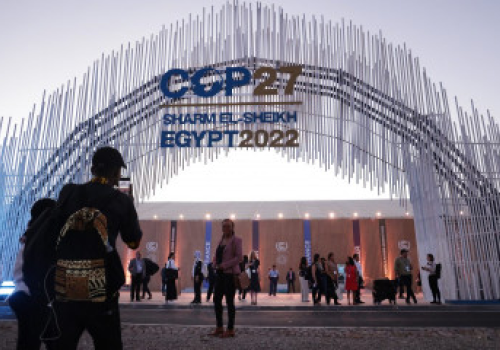Several organisations and government departments working on projects to mitigate the effects of climate change in the Southern African Development Community (SADC) Region made presentations during the SADC Side Event on the margins of the United Nations Climate Change Conference’s 27th Conference of Parties meeting (COP27) in Sharm el-Sheikh, Egypt.
The side event was convened by SADC Secretariat under the title “Best practices and lessons learnt on Intra-ACP Global Climate Change Alliance Plus (GCCA+) programme in the SADC Region”, and presentations were made from the Environment Investment Fund of Namibia (EIF), Grow a Tree Foundation (GTF) from Zimbabwe, Terrestrial Restoration Action Society of Seychelles (TRASS), South African Institute of International Affairs (SAIIA), and Global Water Partnership Southern Africa (GWPSA).
Mr Cosmos Shaduka the project manager of EIF Namibia gave an overview of his project saying it seeks to promote adaption of solar energy and de-carbonise the agriculture sector in Namibia through implementing solar irrigation and solar powered water projects in the Zambezi Region in north-eastern Namibia. The project is benefitting 800 direct beneficiaries, out of which 500 are female headed households and 300 are headed by men, in the Mukango and Muyako areas. He estimated that the project is indirectly benefitting 3 200 people in the two areas.
Mr Shaduka said the project, supported by the European Union through the GCCA+ programme, started in January 2022 and seeks to increase the use of renewable energy and minimise greenhouse emissions by improving access to clean energy and to further provide local communities with access to alternatives such as solar water pumps in agriculture, thereby moving away from conventional pumping systems that use generators and pollute the environment.
Through engagement with local stakeholders, five boreholes have been drilled under the project and are pumping water to the communities using solar power. Five members from the community, including the youth, were trained to maintain and safeguard the solar gadgets and pumping system. The project is not only providing safe drinking water, but there is an irrigation scheme which is supplying fresh vegetables to the community.
Mr Sibusiso Mazomba from SAIIA gave a presentation on strengthening marine and coastal ecosystem-based adaptation in the national climate responses of SADC coastal and island states. He said marine and coastal ecosystems are still not adequately addressed in many climate response measures and need to be more fully integrated into national and sectoral policies.
His organisation is running a project also funded by the EU and GCCA+ in 10 coastal and island SADC countries, namely Angola, Comoros, Democratic Republic of Congo, Mauritius, Madagascar, Mozambique, Namibia, Seychelles, South Africa, and United Republic of Tanzania.
The project focuses on researching, knowledge sharing, and policy dialogues on the effects of climate change on vulnerable communities in coastal areas and island nations. It uses ecosystem-based adaptation (EbA) to assist communities living in coastal areas and island nations in the SADC Region. EbA is the use of biodiversity and ecosystem services to help people to adapt to the adverse effects of climate change. This involves managing the ecosystems to enhance their resilience to climatic shocks and stresses. EbA also involves maintaining and, where possible, enhancing the quality and quantity of ecosystem services they provide to society, and in so doing, supporting communities to adapt to current and future climate risks.
Mr Mazombaa said coastal populations in Southern African countries are also reliant on marine and coastal ecosystems to support their economies and the livelihoods of their people. EbA is therefore important in providing, supporting, regulating cultural ecosystems service, contributing to the development needs and enhancing socio-economic development goals.
The project builds on past research conducted in four SADC Member States which highlighted a lack of inclusion of EbA in policies of coastal countries in the Region; and lack of regional cooperation among Member States to manage and protect vital ecosystems.
SAIIA pursues a multistakeholder approach to include national policy makers, regional institutions, researchers, Non-Governmental Organisations, the academia, research and community-based organisations.
Mr Mazomba said SAIIA seeks to establish evidence base for the potential of EbA in SADC coastal and island countries to adapt to climate change while supporting job and livelihoods opportunities. The organisation also seeks to strengthen EbA action by SADC coastal countries through the revision and inclusion of EbA in the NDCs and other climate policies; and strengthen inclusive governance of marine and coastal resources.
The project targets integration of coastal and marine EbA in 10 national or regional processes. It is envisaged that the most vulnerable communities to the impact of climate change in coastal areas and islands nations in Southern Africa would benefit from efforts by SAIIA.

